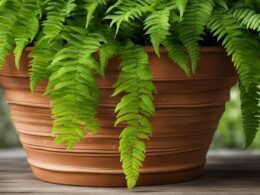House plants are a popular choice for adding greenery to any room, but they can also attract bugs. Chemical bug repellents may be effective, but they can be toxic to pets and children. To protect your indoor plants from unwanted bugs, there are natural alternatives that are safe and effective.
Sticky traps and soil toppers can physically block insects from accessing your plants. DIY bug sprays using soap and water, essential oils, non-essential oils, and neem oil can be used to repel bugs. Some natural sprays can be made by combining different ingredients. It’s important to remember that not all plants are the same, so it’s recommended to test any solutions on a small section of the plant first.
Key Takeaways:
- Chemical bug repellents can be toxic to pets and children, so natural alternatives are recommended.
- Sticky traps and soil toppers can physically block insects from accessing your indoor plants.
- DIY bug sprays using soap and water, essential oils, non-essential oils, and neem oil can repel bugs.
- It’s important to test any solutions on a small section of the plant before applying them to the entire plant.
- Not all plants are the same, so different solutions may work better for different plants.
Physical Bug Prevention
When it comes to protecting your indoor plants from pesky bugs, prevention is key. By implementing physical bug prevention methods, you can create a barrier that deters insects from accessing your plants.
Sticky Traps
One effective and non-toxic option is to use sticky traps. These inexpensive traps can be strategically hung or placed near your plants to trap flying bugs. The sticky surface of the traps will catch insects, preventing them from reaching your plants.
Soil Toppers
Another physical bug prevention method is using soil toppers. These can be in the form of sand, cinnamon, or other materials that create a barrier over the soil. By covering the soil with these toppers, you can prevent bugs from nesting and accessing the roots of your plants.
Diatomaceous Earth
In addition to sticky traps and soil toppers, diatomaceous earth can be a useful tool in your bug prevention arsenal. This powder is made from microscopic sea critters and works by shredding the protective coatings of many insects. It is safe for plants, pets, and children but should be reapplied after watering to maintain its effectiveness.
By utilizing these physical bug prevention methods, you can safeguard your indoor plants and create an environment that is unwelcoming to bugs. Remember to regularly monitor your plants for any signs of infestation and take prompt action if needed.
DIY Bug Sprays
When it comes to protecting your indoor plants from bugs, DIY bug sprays made from natural ingredients can be a safe and effective solution. These homemade sprays are not only better for the environment, but they also avoid the use of harmful chemicals found in synthetic pesticides. Here are some popular DIY bug sprays that you can easily make at home:
1. Soap and Water
A simple and effective option for repelling bugs is to dilute liquid soap in water. Mix a few drops of liquid soap with water in a spray bottle and shake well. Spray the solution directly on the leaves and stems of your plants to deter bugs. The soapy residue will make it difficult for insects to latch onto the plants.
2. Essential Oils
Essential oils are another natural ingredient that bugs find unpleasant. Orange, mint, clove, and lavender oils are particularly effective at repelling insects. Dilute a few drops of your chosen essential oil with water in a spray bottle and apply it to your plants. Lavender oil has been found to be marginally more effective against ants.
3. Non-Essential Oils
In addition to essential oils, non-essential oils like garlic, onion, and cottonseed oil can be used to repel bugs. These oils have shown to be effective at keeping insects and spiders at bay. Mix a few drops of your preferred non-essential oil with water in a spray bottle and apply it to your plants.
4. Neem Oil
Neem oil, extracted from neem trees, is a powerful natural pesticide that repels and kills certain insects. It disrupts their feeding and reproductive systems, making them less likely to infest your plants. Dilute neem oil with water according to the instructions on the bottle and spray it on your plants to keep bugs away.
Remember to always test any DIY bug spray on a small section of your plant before applying it to the entire plant. This way, you can ensure that the spray does not harm or cause any adverse reactions to your indoor plants.
Common Houseplant Pests
When it comes to indoor plants, dealing with pests can be a common challenge. These pests not only damage your beloved plants but can also spread to other areas of your home. Understanding the different types of pests that commonly affect houseplants can help you take the necessary steps to prevent and control infestations.
Spider Mites
Spider mites are tiny pests that feed on plant sap, leaving behind webbing and causing yellowing or discoloration of leaves. They multiply quickly and can infest your plants in no time. Regularly inspecting the undersides of leaves can help you catch them early.
Mealybugs
Mealybugs are small, oval-shaped insects covered in a white, waxy substance. They tend to congregate in warm, moist areas of the plant, such as leaf axils or joints. Mealybugs suck sap from your plants, causing them to weaken and wilt over time. Their presence is often indicated by sticky honeydew residue on the leaves.
Aphids
Aphids are soft-bodied insects that come in various colors, such as green, black, or brown. They feed by piercing plant tissues and sucking out the sap, which can result in curling leaves, stunted growth, and the presence of sticky residue. These pests reproduce rapidly and can quickly infest your indoor plants.
Fungus Gnats
Fungus gnats are small black insects that infest the soil of your houseplants. They thrive in moist environments and are attracted to overwatered or poorly draining plants. Fungus gnats do not cause direct damage to your plants but can be a nuisance. Their larvae feed on organic matter in the soil, potentially disrupting root growth.
Clover Mites
Although less common, clover mites can occasionally infest indoor plants. These tiny, red-colored pests are often found crawling across leaves and stems. While they don’t cause significant damage to plants, their presence can be unsightly and bothersome.
To effectively combat these pests, it’s important to identify them correctly and take appropriate measures. With the right knowledge and pest control methods, you can protect your houseplants and keep them healthy and thriving.
Houseplants That Deter Bugs & Pests
Certain houseplants have natural properties that repel bugs and pests. Incorporating these plants into your indoor garden can help create a bug-free environment without the use of harmful chemicals. Here are some houseplants that are known to deter bugs:
- Basil: This popular culinary herb has a strong scent that insects dislike.
- Mint: Like basil, mint also has a strong odor that insects find repellent.
- Sage and Rosemary: Burning these herbs releases a smoke that repels mosquitoes and other bugs.
- Citronella Plant: The citronella plant emits a citrus scent that mosquitoes find unpleasant.
- Lemongrass: Similar to citronella, lemongrass has a lemony scent that keeps mosquitoes at bay.
- Marigolds: These vibrant flowers have a distinctive odor that deters flies, gnats, and mosquitoes.
- Lavender: Known for its soothing fragrance, lavender is disliked by many bugs and can be used as a natural pesticide.
- Catnip: While cats love it, mosquitoes hate it. Catnip is effective at repelling mosquitoes and can also deter cockroaches.
- Chrysanthemums: These beautiful flowers can repel a variety of pests, including ants, ticks, lice, fleas, bed bugs, and cockroaches.
- Carnivorous Plants: Plants like Venus’ flytrap attract and trap bugs, making them an effective natural pest control option.
Image:
Adding these pest-repelling houseplants to your indoor garden not only enhances the aesthetics but also helps keep bugs away. Experiment with different varieties to find the ones that work best for you. Remember to provide proper care and maintenance to ensure the health and vitality of your plants. Enjoy a bug-free environment with the help of these natural defenders.
Conclusion
Protecting your indoor plants from bugs is essential for maintaining their health and preserving the aesthetic appeal of your home. By utilizing natural bug prevention methods, such as sticky traps, soil toppers, DIY bug sprays, and pest-repelling houseplants, you can effectively keep bugs at bay without resorting to harmful chemicals.
Sticky traps are a cost-effective and non-toxic option that can be strategically placed near your plants to catch flying insects. Soil toppers, like sand or cinnamon, create a protective barrier over the soil, preventing bugs from nesting. DIY bug sprays, made from ingredients like soap and water, essential oils, non-essential oils, and neem oil, offer a safe and environmentally friendly alternative to synthetic pesticides.
It’s important to note that different plants may react differently to bug prevention methods, so it’s always advisable to test any solutions on a small section of the plant before applying them extensively. By incorporating these natural alternatives into your indoor plant care routine, you can effectively safeguard your plants and enjoy a bug-free environment.
What Are Effective Methods for Keeping Bugs Off Indoor Plants?
Keeping bugs off indoor plants can be a challenge, but using the best plant bug spray can be an effective method. Regularly inspecting plants for pests, maintaining proper watering and ventilation, and using natural remedies like neem oil or insecticidal soap can also help keep indoor plants bug-free.
FAQ
What are the natural alternatives to chemical bug repellents for indoor plants?
Sticky traps, soil toppers, and DIY bug sprays using soap and water, essential oils, non-essential oils, and neem oil are safe and effective alternatives to chemical bug repellents.
How do sticky traps and soil toppers help protect indoor plants from bugs?
Sticky traps physically block flying bugs from accessing your plants, while soil toppers create a barrier over the soil to prevent bugs from nesting.
How can I make a DIY bug spray for indoor plants?
You can make a DIY bug spray by diluting liquid soap in water or using essential oils such as orange, mint, clove, and lavender. Non-essential oils like garlic, onion, and cottonseed oil can also be used. Neem oil is another option for a natural bug spray.
What are some common pests that can infest indoor plants?
Common pests that can infest indoor plants include spider mites, mealybugs, aphids, fungus gnats, and clover mites.
Are there any houseplants that naturally repel bugs and pests?
Yes, basil, mint, sage, rosemary, citronella plant, lemongrass, marigolds, lavender, catnip, chrysanthemums, and carnivorous plants like Venus’ flytrap are known to repel bugs and pests.












